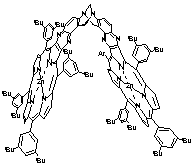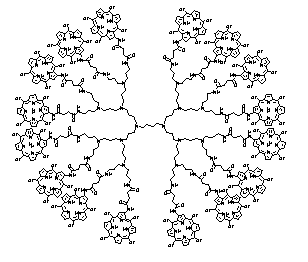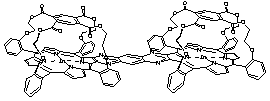Research Program
Research is being conducted in the following areas:
- molecular recognition by porphyrin systems
- porphyrin arrays as models for light-harvesting systems involved in photosynthesis
- new advanced materials
- self-replication and templated synthesis of porphyrin systems
- amino acids and peptides of biological importance;
the underlying theme being that of organic synthetic chemistry
Molecular Recognition by Porphyrin Systems

Novel porphyrin-based chiral cavities are being investigated in studies of molecular recognition of amino acids and nucleic acids. Molecular recognition is used in important biological processes such as smell and enzymic reactions reactions and this study investigates the importance of flexibility/rigidity in host-guest interactions. This study also developed the concept of using very small entities, molecules, as a "molecular ruler".
Porphyrin Arrays as Models for Light-Harvesting Systems Involved in Photosynthesis

Light capture is the first step of photosynthesis. Artificial porphyrin systems designed to mimic light capture in Nature are currently under investigation. New multi-porphyrin arrays assembled on dendrimer cores, are designed to mimic the LH1 and LH2 systems. Novel multi-chromophore wheels will be linked to examine the energy cascade seen in the bacterial light-harvesting antenna array. This research should shed extra light on the mechanism of photosynthesis and may also have application in solar energy devices.
New Advanced Materials
The design and synthesis of new advanced materials based on metalloporphyrins is being undertaken. A novel approach to rigid extended aromatic systems has been further developed to include the synthesis of novel polymers with the potential to behave as electrical conductors and semi-conductors. Synthesis of compounds that allow direct conjunction of the porphyrin pi-system with an external redox centre and use of these compounds to form thin films and as oxygenase models are also investigated. Studies in the areas of molecular switching devices, molecular shift-registers and non-linear optics are also under way.
Self-replication and Templated Synthesis of Porphyrin Systems
 This project seeks to control the outcome of poly-porphyrin synthesis to produce syn-stereoisomers by pre-organising the reactants to disfavour the kinetics of reactions that would lead to anti-stereoisomers. This will be achieved by use of a syn-template to make additional syn-templates. In a sense, this approach overcomes previous limitations of putative 'self-replication' systems that sought to achieve templated acceleration of an already favourable reaction. This project may provide the first unambiguous 'self-replicating' system based on simple unnatural molecules.
This project seeks to control the outcome of poly-porphyrin synthesis to produce syn-stereoisomers by pre-organising the reactants to disfavour the kinetics of reactions that would lead to anti-stereoisomers. This will be achieved by use of a syn-template to make additional syn-templates. In a sense, this approach overcomes previous limitations of putative 'self-replication' systems that sought to achieve templated acceleration of an already favourable reaction. This project may provide the first unambiguous 'self-replicating' system based on simple unnatural molecules.
Amino Acids and Peptides of Biological Importance
Work is underway on the synthesis of non-proteinogenic amino acids and dipeptides of biological interest. Target compounds included novel gamma-lactam antibiotics, the antibiotic and anti-tumour agents, anticapsin and bacilysin, the important metabolic intermediate, arogenate, and dipeptide inhibitors of the enzyme prolidase and of the HIV protease.
Hybrid Porphyrin-Sugar and Porphyrin-Steroid Systems
Recent advances in porphyrin synthesis discovered in Sydney are extended in this project. New concepts in porphyrin chemistry are being developed to yield very hydrophilic porphyrin-sugar hybrids and very lipophilic porphyrin-steroid hybrids and their properties of these novel systems are investigated.






